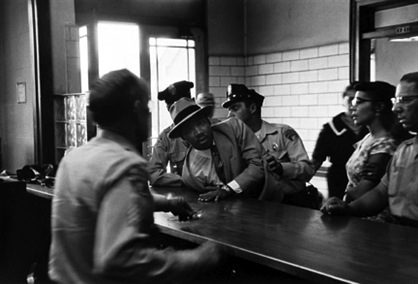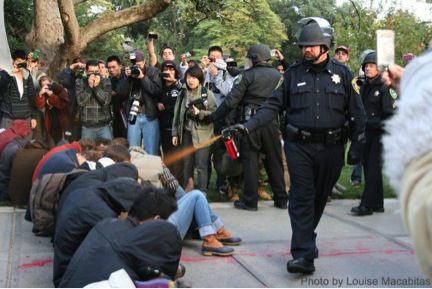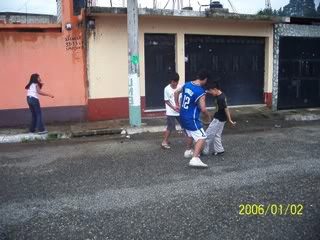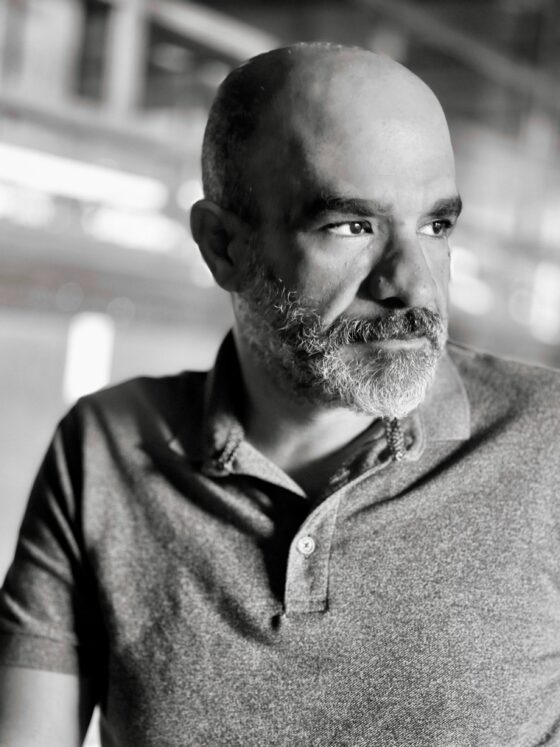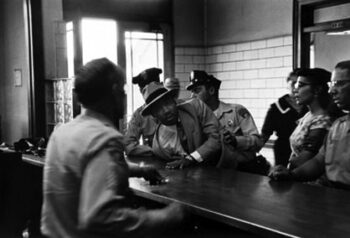
In Charles Moore’s iconic black-and-white photograph, Coretta looks on stoically, lips parted, hands clasped in front as her husband, Martin Luther King, has his right arm bent behind his back by a police officer in a tall hat. Someone unseen, outside the frame, places a hand on Coretta’s left arm, as if to comfort or contain her. Martin pitches forward over a counter, leaning to his right, his left hand splayed out for support on the polished surface. He wears a light colored suit and tie, a panama hat with a black band. The force of the officer’s grip has nearly yanked the jacket off his right shoulder. The officer’s left hand pushes against Martin’s left side, bunching up his jacket, shoving him forward, bending him over the counter. Another officer stands behind Martin’s right shoulder, but you can only see the top of his hat and his right arm resting casually on the counter. A hatless white officer stands behind the counter and our perspective peers over his right shoulder into Martin’s face. He doesn’t look pained. Resigned perhaps, sadly familiar with this sort of treatment. The man behind the counter seems to be reaching out with his left hand to take something or give something (a piece of paper perhaps) from Martin as his right arm blurs at the bottom edge of the frame. Martin, his eyes pulled all the way to the right, is either looking at the man behind the counter or at someone else we can’t see. The date is September 3, 1958 in the Montgomery, Alabama county courthouse. Martin Luther King Jr. is there to support his longtime friend, Ralph Abernathy, a Baptist minister testifying in the trial of a deranged man charged with chasing Abernathy down the street with a hatchet. In the photo, King has just been arrested for loitering. He will spend fourteen days in jail as punishment for his crime. The strange thing is that in Moore’s photograph it is not Martin or Coretta who look afraid. It’s the policemen who appear flustered and scared. The photo is superficially silent. But you can still see how blurry with fear they are of his power and presence, quivering before his radical subjectivity in that space.
***
Loitering is not particularly difficult or physically demanding. It doesn’t, at first blush, appear revolutionary or even criminal. Consider that “loiter” is an intransitive verb. There is no object to it. It is all subject and subjectivity. To loiter requires simply that you stand around or sit aimlessly, without purpose, to choose a space because it happens to be in the shade, or just happens to be there. Anywhere. The key to pure loitering—the most honest embodiment of the word’s spirit—is of course to do nothing. Absolutely nothing.
But it has become bigger than that. Revolutionary. To do nothing now in the name of loitering is also to repurpose in the name of purposeless an otherwise purposed space. And we are surrounded by purposed spaces. To loiter then is a kind of zen-like appropriation, a subjective possession of objective, though often marginal space; and perhaps this is enough to make it revolutionary, enough to threaten those who are invested in the purposing or owning of such space. It worries us when someone does nothing, even when they seem to be doing nothing on a street corner, a roadway median, an alley or some other marginal space. We’re so busy, so purposeful; and in our world of increasing technological connection, we’re always engaged in some activity. It’s hard for us to understand the nothingness of loitering.
Part of the trouble is that it is nearly impossible to define “doing nothing” from “doing something,” so people who truly loiter assume a kind of vague, dangerous amorphous potentiality. The ambiguity of their physical and moral position frightens us. After all, when is any one of us actually doing nothing in any space? Have you ever truly done nothing?
Even when I putter around my yard or sit on my front porch, thinking about whatever I’m currently writing or reading, aren’t I still doing something, even if that something is only thinking? I’m still using the space with an intent that seems to fit the space. I wonder how long I could loiter on my street corner, just stand around thinking and watching people and traffic without drawing unwanted attention to myself. I wonder if that time would be different if I lived in a wealthier, gated community on the North side of town, one of those places where they don’t really have street corners. What if I just stood around in the middle of a cul-de-sac? Or if I lived in a more poverty-stricken, gang-controlled neighborhood in a different part of town would my loitering embody a different potentiality? Of course it would. The objective nothingness in my loitering allows my subjectivity to be shaped to the expectations of the context.
Loitering then as an idea is as undefined, abstract, and subjective as happiness or suffering. It can be adapted and appropriated, shaped to fit the situation; and then laws or ordinances or signs that attempt to regulate loitering are the ontological equivalent of ordinances regulating or controlling happiness or suffering. They are perhaps the most common legislative manifestations of the conflict between subjective intent and attempts at objective measurement of said intent.
Sometimes I think about this when I visit the Food King market in my neighborhood, a subjectively happy place, a true neighborhood convenience store. It feels like home to me. I don’t even care that it costs me nearly twenty dollars for two six-packs of beer. The brothers, Mo and Najib, who own the Food King, emigrated to the U.S. from Yemen and are exceedingly nice to me, always calling me by name. They know most of their customers by name; sometimes Najib’s bespectacled son sits behind the counter working on his homework. Mo and Najib often talk about the weather and they’re usually listening to NPR on the radio. But they also have prominent “No Loitering” signs posted on the front of the store and a bank of video monitors that allow them to keep and eye on every part of their property. You have about as much time to linger in front of the Food King as you do in front of an airport. Pause too long and you will be hustled along.
Mo and Najib have to deal with challenges I can barely imagine. Fresno is a dangerous place filled with desperate people. Nobody really denies this reality. We just live with it. But Mo and Najib run a tight ship, more than most places. They keep their store clean and free of the crowds that loiter around elsewhere. They never hesitate to chase off the street-kids and panhandlers, the tweakers or the prostitutes; and I have to admit that I appreciate this, that it makes me feel somewhat safer as a consumer.
When I asked Mo one day about his “No loitering” signs and how he enforces the rule, he told me that he just tells any loiterers to move along, and if they don’t move, he might threaten to call the police.
“But would they come?” I asked.
“Yeah, sure. Maybe. But if you just mention the police, they mostly move along.”
“And if they don’t?”
“If they don’t, I take my stick out there and I tell them I’m gonna count to three and then I’m gonna hit you with this stick.”
Mo didn’t show me his stick but I guessed it was some kind of baton. I didn’t doubt his conviction. Mo meant business. To him the issue was all black-and-white, no gray area, no room for interpretation. This was his property, his Food King, and he was in charge of defining loitering in this subjective space. He also told me he had a gun under the counter if it came to that.
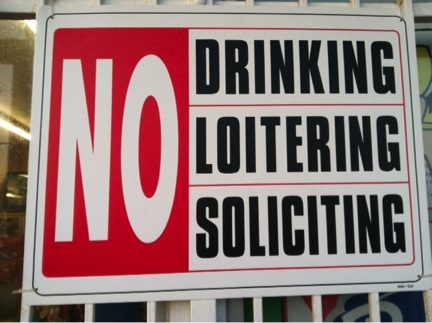
***
Perhaps the most extreme example of the threatening potentiality of loitering is in the context of an elementary school, an exaggeratedly purposed and morally charged public space. If you stand around outside the playground fence of a school, just stand there long enough, most likely your loitering will be seen as a threat and you will most likely be confronted by authority figures. In Fresno all the schools are surrounded by six-foot chain-link safety fencing. If you’re loitering around a school, regardless of your intent (maybe you’re studying the architecture of schools for a class) you might be arrested or at least just hassled and hustled along. There are signs posted everywhere forbidding all manner of activities, including dog walking, golfing, model-airplane flying, and loitering; and as a parent of elementary school children, I’m glad to see those signs when we take our dog there for walks. I don’t really care if you’re flying model-airplanes at my daughter’s school, but I do care if you’re loitering there. It doesn’t matter to me if you’re innocently researching something for a novel or an essay, maybe snapping photos with your IPhone, I just want you to move along and take your subjectivity elsewhere. An elementary school is a place where the objective truth of the context overwhelms the subjective truth of anyone who moves through the space. Your rights are necessarily limited there, and it doesn’t end at the fence. The rights-defining power of an Elementary School space extends well beyond the fences, past the sidewalks, into the streets, where the rules of driving are more stringent and more morally charged, and even further beyond into surrounding neighborhoods, where legal penalties for things like narcotics trafficking are increased. In such spaces the objective meaning of the place overwrites your subjective intent.
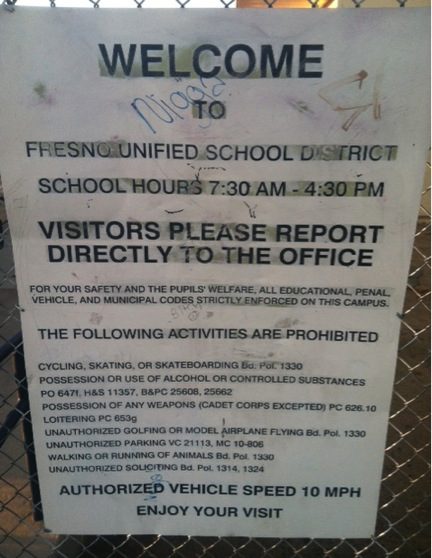
***
It is also the vague undefined nature of loitering combined with the impossibility of truly knowing or measuring subjective intent that has allowed anti-loitering laws and ordinances to be used as a weapon against civil disobedience. Martin Luther King was arrested because anti-loitering laws on the books in Montgomery allowed the police, regardless of the facts of that day, to define King’s presence, to shape his intent into something criminal, something they could use to control him. He was just attending a public trial. But anti-loitering laws allowed the police to arrest him for being black in a white space.
Attempts to criminalize loitering have been used more recently to try and control gang activity, drug sales, panhandling and prostitution, as well as to control populations of homeless people and protesters in the nationwide “Occupy” movement. These efforts, though often temporarily successful, are often doomed to failure, perhaps because of the very nature of loitering itself. Courts have recognized that anti-loitering laws often encourage racial profiling and police abuse of marginalized groups. Legislating loitering is like legislating nothingness.
In February 2012, New York City settled a class action lawsuit brought on behalf of thousands of citizens arrested over the years on anti-loitering charges that had been deemed unconstitutional. The city’s efforts to control loitering over a span of thirty years will ultimately cost them fifteen million dollars and require them to expunge thousands of arrests and convictions. There is little evidence to suggest, however, that this will change the way anti-loitering laws and ordinances are used to control marginalized populations in this country. We are simply too purposed and possessive of our objective spaces, too frightened by the potential of loiterers.
In other communities, perhaps due to the challenges of defining and enforcing anti-loitering ordinances, business owners are turning to less obviously confrontational, more passive, subjective, and subliminal deterrence methods. They’re turning to sound warfare as a way to avoid the whole messy enterprise of objectively measuring and legislating against subjective intent. Perhaps they’re doing this because it protects them from images of abuse and violence and the cultural resonance created by such pictures.
***
The Mosquito was invented in Wales several years ago.
Moving Sound Technologies has been marketing and selling the Mosquito throughout North America. Many cities, municipalities, school districts, and parks boards use the Mosquito to combat vandalism
The patented Mosquito is a small speaker that produces a high frequency sound much like the buzzing of the insect it’s named after. This high frequency can be heard by young people 13 to 25 years old.
The latest version of the Mosquito is called the MK4 Multi-Age. It has two different settings one for teenagers 13 – 25 years and one setting for all ages.
When it is set to 17KHz the Mosquito can only be heard by teenagers approximately 13 to 25 years of age.
When set to 8 KHz the Mosquito can be heard by all ages.
In case you thought Mosquito is all about annoying sound that would force the loiterers to run for cover you would be in for a pleasant surprise!
The Music Mosquito is a complete music system that will relay Royalty free Classical or Chill-out music that would keep the teenagers away to some extent.
Mosquito has a strong steel body . . .
Mosquito anti loitering device is a handy option to suppress vandalism and the issues of graffiti aggressively.
The Mosquito Device can help with Teen Loitering Problems.
Mosquito has a strong steel body . . .
The Mosquito Device can help with Gang Loitering Problems
Mosquito has a strong steel body . . .
The Mosquito Device can help with Vandalism Problems
Mosquito has a strong steel body . . .
The Mosquito Device can help with Grafitti[1] Problems
Mosquito has a strong steel body . . .

***
At night now in Fresno or in your city they might gather beneath the glow of street-lamps, lurking around its penumbral cone of light. Packs of teenagers. Black kids. Brown kids. White kids. Brawny boys in baggy clothes, hats and team jerseys; pale, inked kids wearing white wife-beaters; girls in skinny jeans, high-heels and higher hair; or a population of bearded men smiling through meth-snaggled teeth, shuffling burnouts and tweakers with face tattoos, gang bangers with bulldog paws or red lips painted permanently on their necks; or maybe it’s those ubiquitous kids at a suburban mall wearing Polo shirts and skinny jeans, high-top sneakers, and puffy Tommy Hilfiger jackets and they’re loitering around Jamba Juice or the movie theater, around your neighborhood school, or outside your business every night. These are the loiterers, the idle enemies of consumption and purpose. These are the targets of subjective warfare.
In my hometown, the high school kids from outlying rural communities used to drive to downtown Lawrence, park their trucks backwards in the diagonal spaces along Massachusetts St. and set up lawn chairs in the beds. They watched the rest of us stroll past as if we were specimens in museums. Often we looked the part. Often things were said. Often there were fights. Often there was litter and vandalism. Several merchants installed strobe lights in the windows of their stores, leaving them on all night long as a kind of light-deterrent, a passive form of loitering enforcement. It worked, too. After a while nobody wanted to park or linger in front of those shops. There were fewer fights there, less litter and vandalism. But the lights also just made the business owners seem kind of mean and intolerant.
It doesn’t matter, really, what loiterers look like for the purposes of the Mosquito or for a strobe light. Such passive forms of loitering deterrence don’t discriminate on the basis of color, class, caste, or clothing choice. They cannot violate rights in part because we have few clear legal protections against noise or light pollution, despite its obvious influence on subjective experiences of happiness or suffering. Noise might not violate your rights. It can’t bend you over a counter and handcuff you, but it can violate your space and subjectivity. It can make it hard to think, even hard to do nothing.
What matters to the Mosquito is not the motivations of the loiterer, but simply that the subjective loitering body courses with blood and has ears with which to listen. In this way it is much like a bomb. A very smart bomb. What makes the Mosquito insidious is how it targets the age of the loiterer, his youth and the way his brain processes sound. Imagine a bomb that only wipes out people of a certain age, a bomb that targets only the young. The mosquito doesn’t care about the kinetic potential for chaos, for unpredictable behavior inherent in their stasis. It doesn’t care about anything because the mosquito is a machine designed to create an automatic physiological response, because its intrusion into your subjective internal space is silent, indiscriminate, and subtly violent.
The danger of loiterers at rest is that bodies will remain at rest until acted upon by an outside force. The danger is the malicious pull of idle hands toward evil deeds. And the popular imagination associates loitering—a behavior defined specifically by its purposelessness—with all sorts of bad or illicit purposes; most notably property crimes like vandalism and graffiti, as well as with gang activity and prostitution. And because there is often little else for them to do, no other place for them to gather, teenagers—the ultimate in-betweeners—are regular offenders of anti-loitering efforts and ordinances. By their very nature, teenagers embody the conflict between objective rules and expectations and subjective intent. They live perpetually in the liminal space between outside rules and their internal wills. Teenagers are all subjectivity, all solipsistic fervor; they are in essence loitering between childhood and adulthood, embodying that marginalized space with intent that is often inscrutable to those of us living outside that space.
In my neighborhood, the loitering teens move between a series of spots, these odd sort of in-between places like the island of a parking lot behind Starbucks and Bobby Salazar’s Mexican restaurant, or someone’s yard, perhaps the community garden, up against the brick wall of the Brass Unicorn and the Starline or in the side-yard of an apartment building on Moroa Ave. You won’t find them outside the Food King, but nearby in side-streets and alleyways, lounging in various liminal spaces.
Much to the chagrin of many Fresno shoppers, we also find loitering teens on the wealthy, north side of town at the clay-colored strip mall called River Park, a palace to consumerism and multi-national corporations that, in effort to curb loitering, not long ago tried to ban unaccompanied teenagers from the premises. That didn’t work so well.
A parent or other objectively recognized adult had to be with any teenager on the premises. It wasn’t clear how the mall intended to enforce this, if they planned to randomly ID anyone who looked young enough to be a teenager. Perhaps they simply should have installed Mosquito anti-loitering devices in the same places they’ve installed Musak speakers and security cameras. We fear teenagers not because of their loitering itself—that gray penumbral area between right and wrong—but because the act of doing so suggests, by its mere existence, the possibility for harm, for mayhem and destruction. We fear their unbridled youth and all of its sublime potentiality. We fear their marginalization because it lives outside the boundaries of our control.
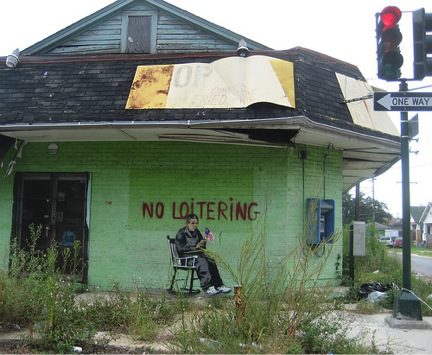
***
One day not long ago as I was driving home from lunch with a friend, I took a side street that parallels a major thoroughfare, a street known as a popular hangout for the Fresno street kids and the homeless. A homeowner who has been working on remodeling a large house that backs up to the street recently installed a painted wooden fence and stacked-stone planters surrounding mature pomegranate trees. He’s created a lovely little oasis of landscape architecture that would appeal to nearly anyone’s aesthetic; and as I drove past this oasis, I saw a loose pack of loitering teens lounging around the planters, smoking, pawing at each other, laughing, and doing nothing. All of them. Loitering. Just sitting there, doing nothing. And I felt this momentary urge to yell at them or drive them away somehow, but I wasn’t sure why. Perhaps it was jealousy. Perhaps it was fear.
Unless I’m writing or reading, I have trouble sitting still for ten minutes. I can’t imagine doing it for 2 or 10 hours. I wondered if the homeowner might want to think about getting the Mosquito anti-loitering device, if he might want to agitate their space and send out high-pitched squeals of deterrent noise. I thought this might be something that I would do if I owned the house; but even as I thought it, I cringed at the idea, the invasion and violation of space, as well as at the aesthetic and moral cruelty of creating an otherwise appealing place that would be simultaneously physiologically repulsive, a space whose 17 MHz of Mosquito noise would hurt the ears of young people.
These days when teenagers loiter across the street from our house, making-out or smoking weed from a can or a pipe or a blunt-wrap, I mostly ignore them. Some days I want to tell them to move along or to just smoke somewhere else. Some days I want to warn them that other people aren’t so understanding, that the police often patrol our street since it’s so close to the high school. But the most I ever do, if I’m out front with my kids, is give the teenagers a hard stare, maybe a wave to let them know I see them, to suggest they might move along.
I’ve thought about calling the police, but the Fresno police frighten me more than loitering teenagers. They shoot people. Pretty regularly. I don’t want these kids to get shot or even arrested. And besides I don’t really want to be that guy–the asshole neighbor who calls the cops on kids. The truth is they’re not hurting anyone except maybe themselves. They’re just hanging around because they can, because they have nowhere else to go. My friends and I did similar stuff in high school. We used to drive out into the Kansas countryside, down empty gravel roads, to find space where we could smoke or drink. These kids like to linger against the tall fence along my neighbor’s side yard and sit beneath the overhanging tree on the stacked railroad ties. It’s only a block from Fresno High School, away from the crush of other kids and just beyond the boundaries of school space. It seems safe enough, like a place where they can loiter in peace.
Who am I to deny them this space?
I watch them sometimes and I think about Mo and his stick, his gun under the counter. I think about the Mosquito and I wonder how I would react if the teenagers crossed the street, crossed the line and started loitering in my yard, if they even got close to my daughter and invaded my subjective space.
I’m not sure I would even count to three.
I like to think I’m a long way from those white officers in Moore’s photograph, those agitated and frightened white men who pressed King against the counter, twisting his arm behind his back, arresting him for eternity in the objective space of that everlasting image. But I realize I’m also guilty. I’ve let my own subjective fear shape the way I define loitering. I’ve let my imagination carry me away, let my own context—home and family, children and dog, yard and garden—condition the meaning of the teenagers’ nothingness and I’ve let it color their lingering at the periphery of my space. The street is the line, I tell myself. It’s a wide and fuzzy boundary between us. But it is a boundary.
One day a boy crossed the line. He approached the house. The kids were in the front yard. My girlfriend met him at the driveway. I’d gone inside for a minute and came out to see her walking back toward the garage. She moved with purpose. I followed her. The boy waited at the end of the driveway.
“What’s up?” I asked.
“He wants to borrow a soccer ball,” my girlfriend said as she smiled and walked past me, down the driveway and tossed him the ball. I felt my blood cool, retreating from full-boil. There was no danger, no threat. There was nothing for me to fear.
“It’s OK,” she said.
The boy and his three friends, another boy and two girls, set up “goals” in the middle of the street made of wadded-up fast-food bags and wrappers. They played soccer on the asphalt for a while, darting out of the way when cars came. They were out there long enough for my kids and I to drift back inside. The boys flirted shamelessly with the girls and showed off with the ball. All of them laughed a lot. They seemed so happy. I watched them through the windows near the front door, listening to the sounds of their youth. They moved with ease and grace between the curbs, lingering in the in-between spaces with such sweet purpose.
***
[1] Sic. All italicized passages taken from the Moving Sound Technologies website.

